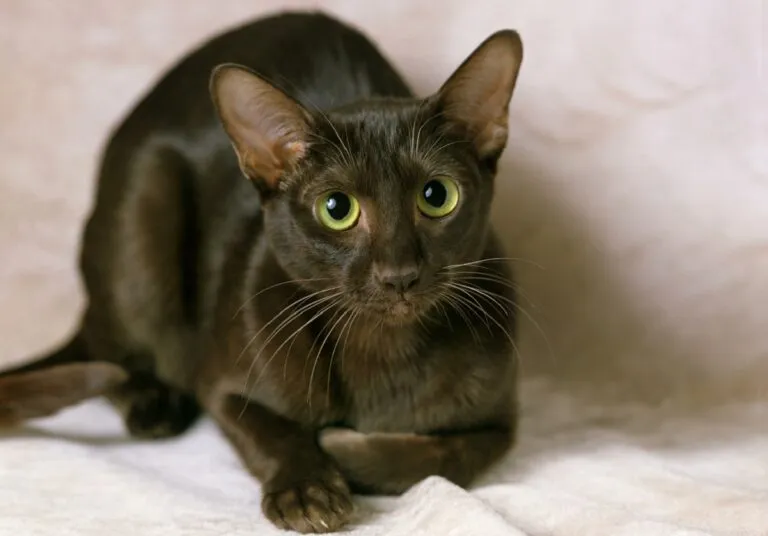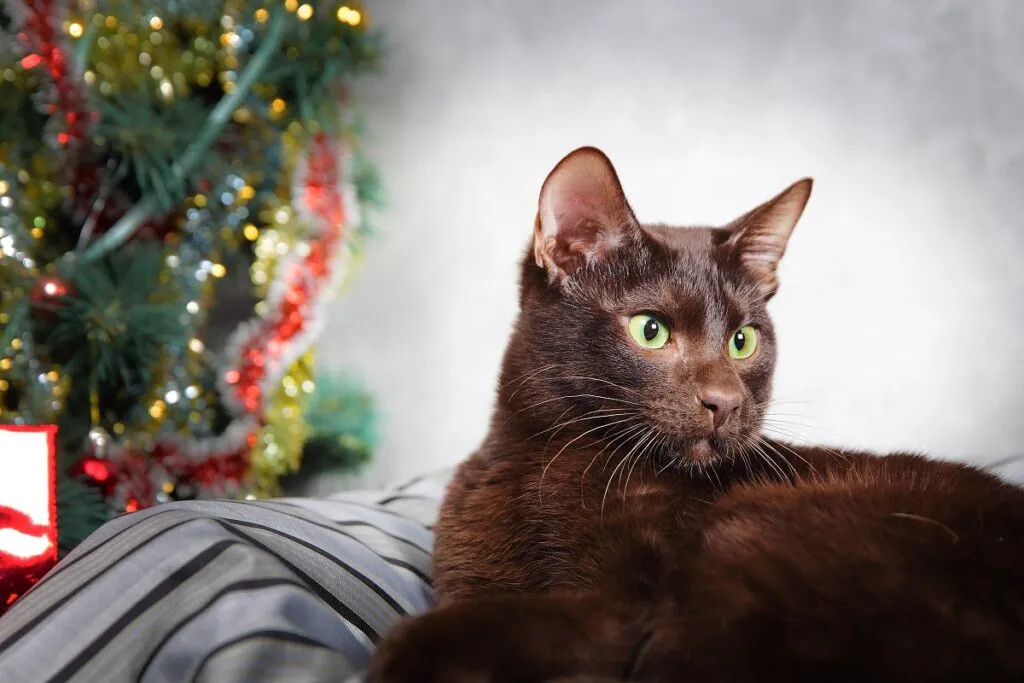Maine Coon
The Maine Coon has become one of the most popular cat breeds in the world. This is probably due to its majestic appearance, robust nature and great character.
The exact origins of the Havana Cat are a little unclear, but one thing is for sure: these dainty, playful felines prefer to stay indoors, following their humans wherever they go. Discover more about this rare breed with the fine mahogany-colored fur here.

© slowmotiongli / stock.adobe.com
The Havana cat boasts a remarkably glossy and fine coat.
The Havana Cat belongs to the Oriental Shorthair family and is a striking beauty. Tipping the scales at no more than four kilograms, they exhibit both muscular strength and grace. It’s their angular head and unique radiant brown coat colour that give the breed its exotic appearance.
The medium-sized Havana Cat has an extremely slender, elongated body set on tall legs. Its wedge-shaped head features large, forward-facing ears that lend it its signature character.
The eyes are traditionally light green and slightly almond-shaped, with a muzzle that’s usually quite long and marked with a prominent nose. The sleek torso ends in a medium-length, tapering tail that emphasises the Havana Cat’s graceful figure.
A hallmark of the Havana Cat is its short and sleek brown fur, which conjures images of mahogany and chocolate. Accepted colour nuances range from brown to reddish-brown, with the breed invariably being solid-coloured — patterns and markings are not part of their standard.
New Colour The Havana Cat is a rarity. To diversify the gene pool, some breeding associations have now included the colour Lilac — a beige with a slight bluish tint — in their breed standard.
The Havana Cat is known for being intelligent and playful. Toys, climbing structures, and scratching posts are all enjoyed with delight by the curious Havana. However, their bursts of activity are usually short-lived, as they have a relatively low energy level.
Playing, cuddling, and interaction throughout the day certainly align with their preferences. This affectionate, people-oriented cat does not take well to being alone; it simply loves to curl up on a lap, and is very loving in its interactions, even with children.
There are times, though, when the Havana Cat seeks solitude and may become a little grumpy. At such times, it’s best not to pick up the cat but rather give it the space it deserves. Rest assured, your faithful feline will be weaving around your legs again in no time.
Additionally, the Havana Cat enjoys “talking” with its housemates, though it doesn’t tend to meow quite as much as the Siamese Cat. It can be shy around strangers.
The Havana Cat is an indoor,house cat through and through. It enjoys the comfort of a warm home, seeking social connections and play opportunities.
Naturally, during warmer months, it might venture onto the balcony or into the garden when doors are open, but only under optimal weather conditions. Otherwise, it prefers a cozy spot next to the heater.
The Havana Cat demands time and dedication. It picks its favourite humans and forms strong bonds. When your Havana Cat approaches you, it’s likely an invitation to engage and entertain.
It is very intelligent, responsive, and loves being presented with new challenges regularly.
Havana Cats like children, as long as their boundaries are respected, and they’re not hassled, like having their tails pulled.
Other cats or dogs living in the household are usually not an issue for the Havana. This adaptable kitty can get along with other animals, ensuring harmonious living.
Your Havana Cat doesn’t enjoy being left alone. So, avoid leaving it for extended periods. It loves being the centre of attention and fully engages in social activities.
During these moments, the kitten may comment on what’s happening with its gentle voice, seeking to elicit reactions from its humans. After active phases, the Havana seeks physical contact for cuddling, resting, and a bit of affection.
The Havana Cat requires a normal, species-appropriate diet. Fresh wet food, with some variety, should form the basis of its diet, occasionally supplemented or replaced by dry food. A bowl of fresh water should always be accessible.
In general, the Havana Cat is not a big eater. It can be rather fussy with its food, so feel free to explore the wide variety of options available.
The Havana Cat naturally boasts shiny fur that needs little coat care. From time to time, you can brush it with a soft cloth or brush. Your little tiger will surely relish this intimate attention and the extra affection.
Taking on a Havana Cat means choosing a robust animal that seldom falls ill. You’ll likely only need to visit the veterinarian for routine check-ups and regular vaccinations.
If your cat’s fur loses its shine or it exhibits unusual behaviour, then something isn’t right. Please have your Havana checked out promptly.
Havana Cats typically live between 15 and 20 years.
Beware the Cold Havana Cats quickly feel the chill and thus avoid cold and draughty spots. Never lock your cat out of the house, so it can seek warmth if necessary.
There is much speculation about how the Havana Cat got its name. Some believe it was inspired by Havana rabbits which share the same fur colour.
Others think the origin of the name might be linked to Cuban tobacco, which is as chocolate brown as the cat. However, it remains a mystery why the Havana Cat is spelt with a single ‘n’.
There are various theories surrounding its history. One story begins in Thailand, where the breed supposedly arose from crossing Tonkinese and Burmese cats.
Another traces back to England, where breeder Baroness von Ullmann is said to have crossed a Siamese cat with a European Shorthair in 1952, making her male cat “Elmtower Bronze Idol” the progenitor of the breed.
What’s certain is that humans played a part in this breed’s creation — it didn’t evolve naturally. The Havana Cat enjoys popularity overseas and goes by many other names, including:
 © bozhdb / stock.adobe.com
© bozhdb / stock.adobe.com
Since the Havana Cat is quite rare, and the breeders’ network is sparse, be prepared for a higher purchase price. Expect to pay between £1,000 and £1,200 for one of these cats.
When choosing a breeder, make sure that they specialise in Havana Cats, can provide all health certificates and have a traceable pedigree.
Since the Havana Cat has a strong personality and forms deep bonds with its owner, it’s not recommended for beginners. Be aware that this cat will have its demands for your attention. After a tiring day, catering to its needs might be the last thing you want!
However, if you can’t think of anything more delightful than a clingy, playful cat to whom you mean the world, then you’ve found your dream feline.
| Brief info: | Charming, playful cat with an oriental appearance well-suited to indoor living |
| Shoulder height: | 25cm |
| Weight: | 2.5-4.2kg |
| Average Lifespan: | 15-20 years |
| Price: | £1,000-£1,200 |
| Nature: | Communicative, affectionate, playful, intelligent |
| Coat: | Shorthaired |
| Coat colours: | Solid, chocolate brown to reddish-brown |
| Grooming efforts: | Low |
| Energy level: | Moderate |
| Origin: | Unclear |
Here are some purchase proposals curated by the zooplus editorial team
The products featured have been carefully selected by our editorial staff and are available at the zooplus online pet shop. The selection does not constitute advertising for the mentioned brands.
The Maine Coon has become one of the most popular cat breeds in the world. This is probably due to its majestic appearance, robust nature and great character.
Large eyes and attentively upright ears instantly tell you a great deal about this charming breed of cat: Abyssinians are inquisitive and affectionate towards people.
With its long, dense fur, rounded ears, and intense stare, the Pallas Cat, or Manul, looks rather fluffy, yet somewhat dangerous. However, don't be fooled by its appearance—this is no petting zoo resident. The Manul is a wild animal and considered untameable.